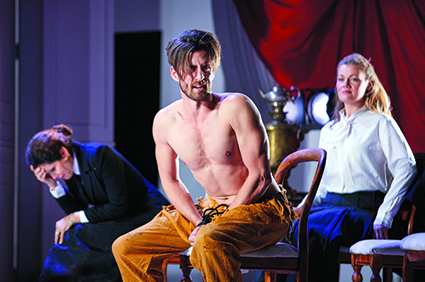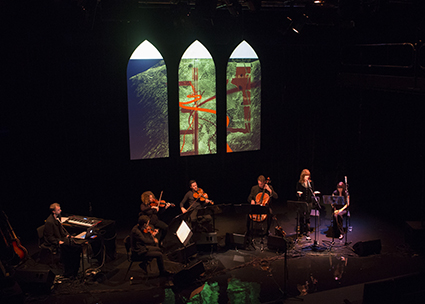 |
Bajazet photo Keith Saunders |
Not surprisingly then, 17th and 18th century English writers changed the endings (and more) of Shakespeare’s tragedies—most famously Nahum Tate, 1681, saves Lear and Cordelia marries Edgar. Adaptation is just as rampant today, with varying degrees of sensitivity. In Benedict Andrews’ Measure for Measure at Belvoir (2010), Isabella, about to be married to the Duke in a final tableau, steps outside the production’s video frame and runs for her life into the audience. The play, in the Andrews manner, is otherwise left pretty much intact unlike, say, Barrie Kosky’s radical rewrite of Lear for Bell Shakespeare in 1998 with evil absolutely triumphant. I welcome adaptations of classics—they’re well-known and we can respond to the intellectual challenges of directorial conceits. For lesser or barely known works ‘adaptation’ seems pointless. (I liked Thyestes [Belvoir, 2012], but what was it an adaptation of? Something far removed from the little known play by Seneca the Younger.)
Pinchgut’s Bajazet is faithful to the tenor of the libretto almost to the end, when Astrea, daughter of the defeated Turkish emperor Bajazet, and the Greek prince Andronicus, lovers hitherto under threat of violent deaths, are handed Greece and marriage by a suddenly benign Tamerlano. As everyone around them celebrates in glorious chorus, Astrea and Andronicus take poison, presumably unconvinced that the unpredictable Tamerlano’s beneficence is likely to be enduring. It’s an ending at once disturbing and irritatingly out of kilter with the strength of character revealed in the couple, particularly Astrea. Instead of fatalism the director might have opted for just as fanciful defiance with Astrea poisoning Tamerlano (the actual Timur was pretty much at the end of his nasty career). Who wants ISIS to win out over its courageous opposition?
I should have seen the ending coming. Looking pretty much like any number of Baroque opera productions of recent decades, this Bajazet is historically displaced, from 15th to 19th century, and given a quasi-Victorian look, the men in white and cream riding outfits, the women in (not very full) skirts, the simple set comprising a huge white bookcase on one side and an equally large double door opposite, both white. Furniture and statuary are scattered about and a high, wide red curtain hangs at an angle at the back—signs of pillage after conquest. There are oddities: Bajazet dressed in traditional Turkish attire, Tamerlano in European whites, not at all the Tartar, save the swagger.
However in Act II, the shelving has been cleared of books, the trophies of war displayed and Tamerlano, about to take action, dons Arabic head-dress and shortly appears entirely ISIS-like in black to condemn Astrea to rape and death by a mob. It’s a slow reveal of the extent of Tamerlano’s destructive vision from which Astrea and Andronicus feel they can never escape and therefore opt for death. The man they initially meet is not just another well-dressed conqueror. It’s not an altogether convincing logic. I would have preferred some consistency in costuming and an overall sense of clarity of purpose from the start as seen, for example, in Peter Sellars’ production of Handel’s Theodora—the conceit of the Texas capital punishment death machine is laid over the Roman persecution of Christians and immaculately realised, aesthetically and politically. (Theodora is scheduled for production by Pinchgut in 2016.)
Just what’s to be gained by setting Bajazet in the 19th century is never made clear. There are also plenty of distractions: Grand Guignol skeletons—Tamerlano’s victims—leaning in to watch from the balconies; too much dragging in, out and about of furniture by busy supernumeraries; a stuttering raising of the red curtain mid-aria in Act 1; and the sudden silhouetting and then tight spotlighting of singers as they hit the high notes of their arias—as if the singing could not carry the day.
Despite its conceptual and design flaws Bajazet nonetheless shone because of superb singing, acting, musical direction and period instrument playing. It’s to the credit of director de Mallet Burgess, conductor Erin Helyard and all the singers that the performances were so finely tuned, emotions clearly expressed and the oscillations between the private and public selves of the characters so well delineated. Despite the sprawl of the narrative and the too busy staging, the production dwelled intently on each moment while building tension towards a frightening conclusion, if one made fatalistically grim.
 |
Orpheus Song, (L-R) David Trumpmanis, Ewan Foster, Stephanie Zarka, James Eccles, Geoffrey Gartner, Andrée Greenwell and Julia County photo Matthew Duchesne, Milk and Honey Photography |
Andrée Greenwell, Gothic
Since the late 18th century, the Gothic has never passed its use-by date, periodically rising wraith-like from the depths of the collective unconscious as high art, pulp fiction, fashion and youth sub-culture and nowadays overpopulated with vampires, werewolves, zombies and the common or garden ‘returned’ (see review of Glitch). One of the few practising stalwarts of Australian music theatre that is neither opera nor musical theatre, the ever-inventive Andrée Greenwell, premiered her Gothic during Sydney’s Vivid Festival. Hers is a quieter, subtler take on the genre than most, but still blessed with eeriness and occasional horror.
Gothic is a seamless theatricalised concert, its background three tall church windows (design Neil Simpson) which become screens for digital (and psychological) projections by London-based Australian media artist Michaela French. In the foreground is an ensemble of instrumentalists and two singers—Greenwell herself, often delicately ethereal, and Julia County, a soprano with a daunting range and enveloping delivery. I’ve limited myself to the songs and imagery which I thought represented the best of the concert.
In her folk/classical setting of Edgar Allen Poe’s Annabel Lee, Greenwell’s voice intertwines with violin as the land and seascape of “the sepulchre/in this kingdom by the sea” mysteriously mutates, the animation ‘panning’ from a small house on an island to a distant city to the accompanying lap of ocean waves as the teller “lies down by the side/of my darling…In her tomb by the sounding sea.” The Cure’s gothic rock “A Forest” (1980), one of the more frightening of the program’s songs, opens with the sounds of a child’s voice, crickets and “Where are you?” cries, conjoined with ghostly black and white etchings rhizomatically transforming into forest branches and shafts of light which seem to propel the accompanying strings.
Another lost soul—a child in the throes of being snatched away by a supernatural force —is the subject of Greenwell’s pulsing string quartet arrangement of Schubert’s The Erlking. Soprano and cello entrancingly share the melody while images of children in 19th century apparel appear and fade before the many windows of big city buildings—as if still with us as ghosts in our own century. Another lost to powers beyond the human is felt in poet Alison Croggon and Greenwell’s haunting The Orpheus Song, the composer adding the sound of responses to the 2011 Joplin Tornado in Missouri, USA as it struck, recorded on an iPad. A red line spreads and threads its way across the windows—a red path of destruction? Chosen Words by writer Maryanne Lynch and Greenwell is one of the strongest of Gothic’s compositions with its account of a woman kept in her grandfather’s cellar for 19 years. Greenwell and County vividly voice the sense of threat and the yearning for escape while a series of images of suburban houses flicker by, evoking a domestic banality of evil.
Gothic climaxed with Poe’s “The Bells,” the instrumentation resonating with the animations of huge bell mouths swinging towards us and then being rendered abstract, taking us with them into oblivion. Angelo Badalamenti’s Twin Peaks theme, “Falling” (1990), provided an apt coda to Gothic, a solo guitar arrangement with electronics for a composition as enticing as it is disturbing—which is the uneasy charm of the Gothic. Greenwell’s curation, composing and arranging made for a fascinating program not least in the engagement between live music and media art.
Pinchgut Opera, Bajazet, composer Antonio Vivaldi; City Recital Hall, Sydney, 4-8 July; Gothic, artistic director Andrée Greenwell, electronic processing David Trumpanis, Vivid, Seymour Centre, May 28-30
RealTime issue #128 Aug-Sept 2015 pg. 47
© Keith Gallasch; for permission to reproduce apply to [email protected]








 back
back